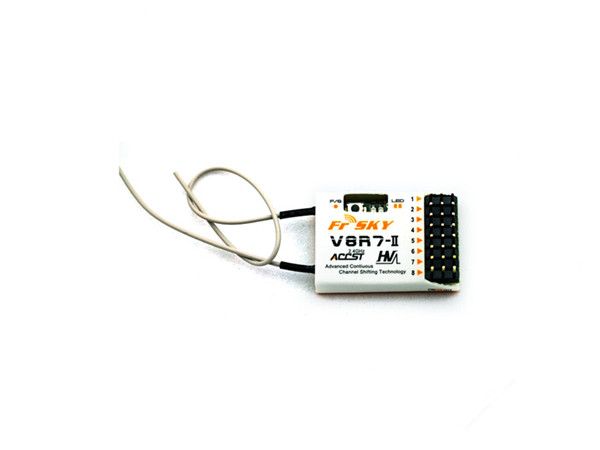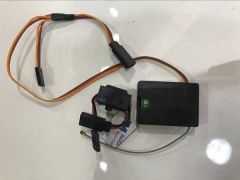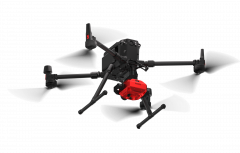FRSKY V8R7-II 7 CHANNEL 2.4Ghz RECEIVER
The V8R7-II is Frsky's new standard 7 Channel receiver.
This receiver will operate as normal with your Telemetry module without having to switch over to none telemetry mode. Also compatible with the none telemetry modules - as well as with both the TARANIS TX and the XJT module too.
1.1 Compatibility

1.2 Specifications
- Dimensions: 33.5x22x12mm
- Weight: 5.2g
- Operating Voltage Range: 3.0~16.0V (HV version)
- Operating Current: 30mA
- Specified Range: full range (>1.5km)
1.3 New feature of V8R7-II over V8R7-HV
Compatible with all FrSky modules (V8_mode & D_mode) receive only (V8R7-II can talk with module of either mode but it does not send telemetry information back to the transmitter).
2. Set Up
2.1 Bind procedure
- 1. Turn on your transmitter and switch it to PPM mode. Turn the transmitter off.
- 2. Turn on the transmitter while holding the F/S button on the transmitter module. Release the button. The RED LED on the transmitter module will flash indicating the transmitter is ready to bind to the receiver.
- 3. Put V8R7-II into binding mode (see 1.1 Compatibility chart for details) the LED on V8R7-II will flash indicating the binding process is completed.
- 4. Turn off both the transmitter and V8R7-II (and disconnect the jumper from V8R7-II after binding with telemetry module in D_Mode).
- 5. Turn on the transmitter and connect the battery to V8R7-II The GREEN LED on the receiver will indicate the receiver is receiving commands.
The transmitter module/receiver binding will not have to be repeated unless one of the two is replaced.
2.2 Range check
A pre-flight range check should be done before each flying session. Reflections from nearby metal fences concrete building or trees can cause loss of signal both during range check and during the flight.
The following steps are to be followed to perform the range check of the model before the flight:
- 1. Place the model at least 60cm (two feet) above non-metal contaminated ground (e.g. on a wooden bench).
- 2. The receiver antennas should be separated in the model and do not touch the ground.
- 3. Place the antenna of the transmitter in a vertical position.
- 4. Turn on the transmitter and the receiver press the F/S button of the transmitter module for 4 seconds to enter range check mode the RED LED of the transmitter module will be off GREEN LED will flash rapidly. The effective distance will be decreased to 1/30 of full range.
- 5. Walk away from the model while simultaneously operating the controls on the transmitter confirming that all controls operate normally to a distance of at least 30 meters (~30 yds).
- 6. Press the F/S button of the transmitter module for 1S-4S to exit range check mode RED LED will be back on indicating normal operation is back.
2.3 Failsafe setting
Failsafe is a useful feature in which all controls move to a preset position whenever the control signal is lost for a period of time. V8R7-II supports failsafe function for all channels.
Follow the steps below to set failsafe positions for each channel:
- 1. Bind the receiver first and turn on both the transmitter and the receiver;
- 2. Move the controls to the desired failsafe position for all channels;
- 3. Press briefly the F/S button on the receiver (less than 1 second). The GREEN LED of the receiver will flash twice indicating the failsafe position has been set in the receiver.
To disable the failsafe function just re-bind the receiver.
Failsafe is recommended to set when system is first used or receiver has been re-bound. Follow steps below to set failsafe.
Option-1. How to set failsafe to a user-determined state on lost signal:
- 1. Bind the receiver to the transmitter module first and turn on both the transmitter and the receiver.
- 2. Move the controls to desired failsafe position for all channels.
- 3. Press briefly the F/S button on the receiver and you are done.
Option-2. How to set failsafe for no pulses on lost signal:
- 1. Just press briefly the F/S button on the receiver while the transmitter is off and you are done.
Note: If failsafe is not set failsafe default will hold the last position before the signal is lost. In this case there is a risk that your model could fly away and/or cause injury.
| Manufacturer | dji |
|---|












